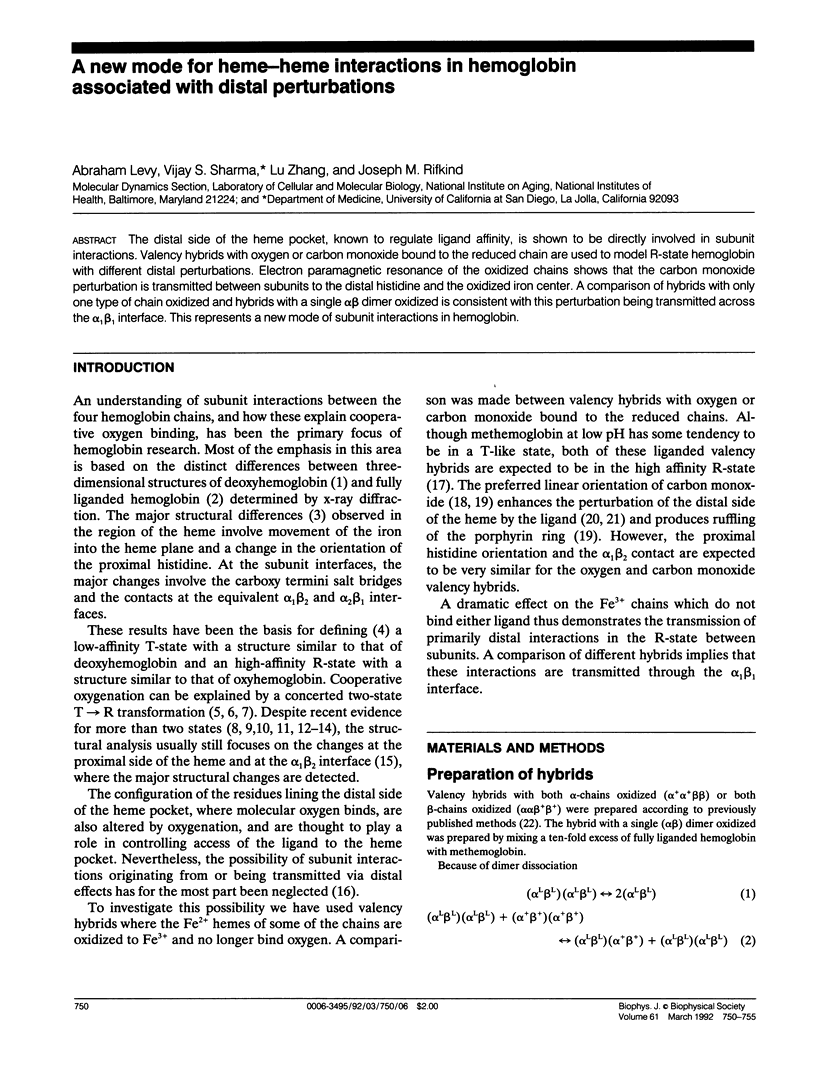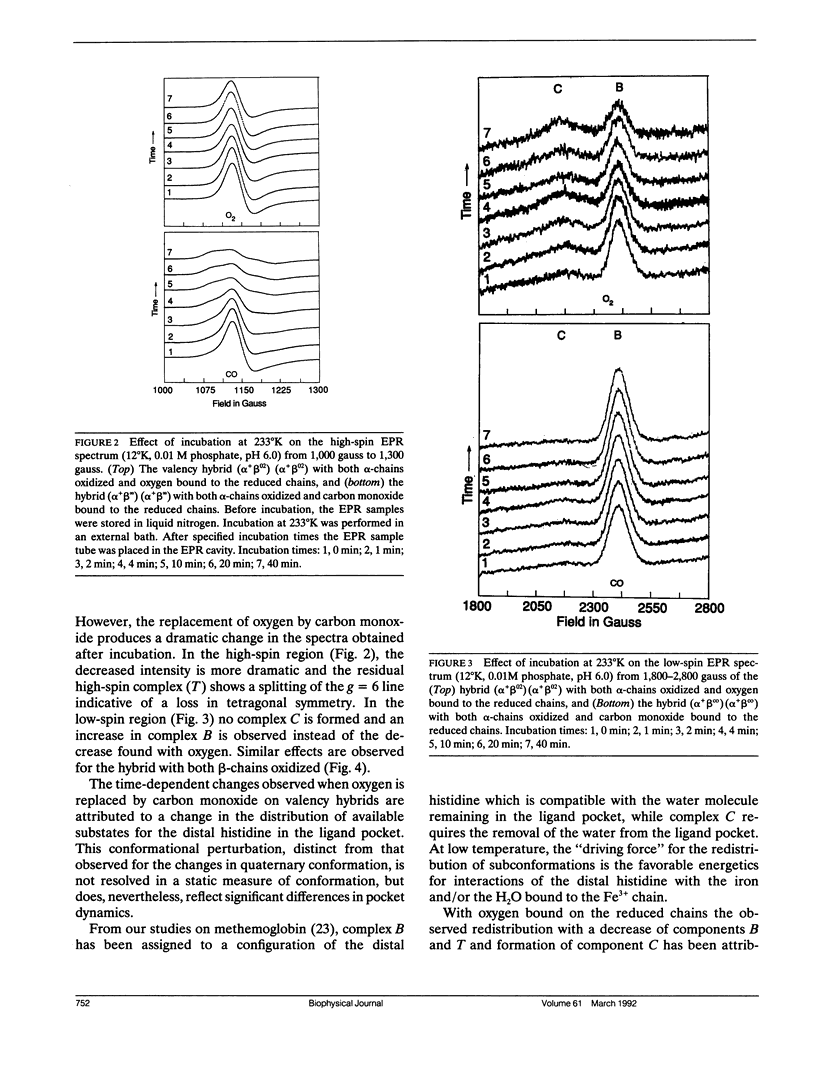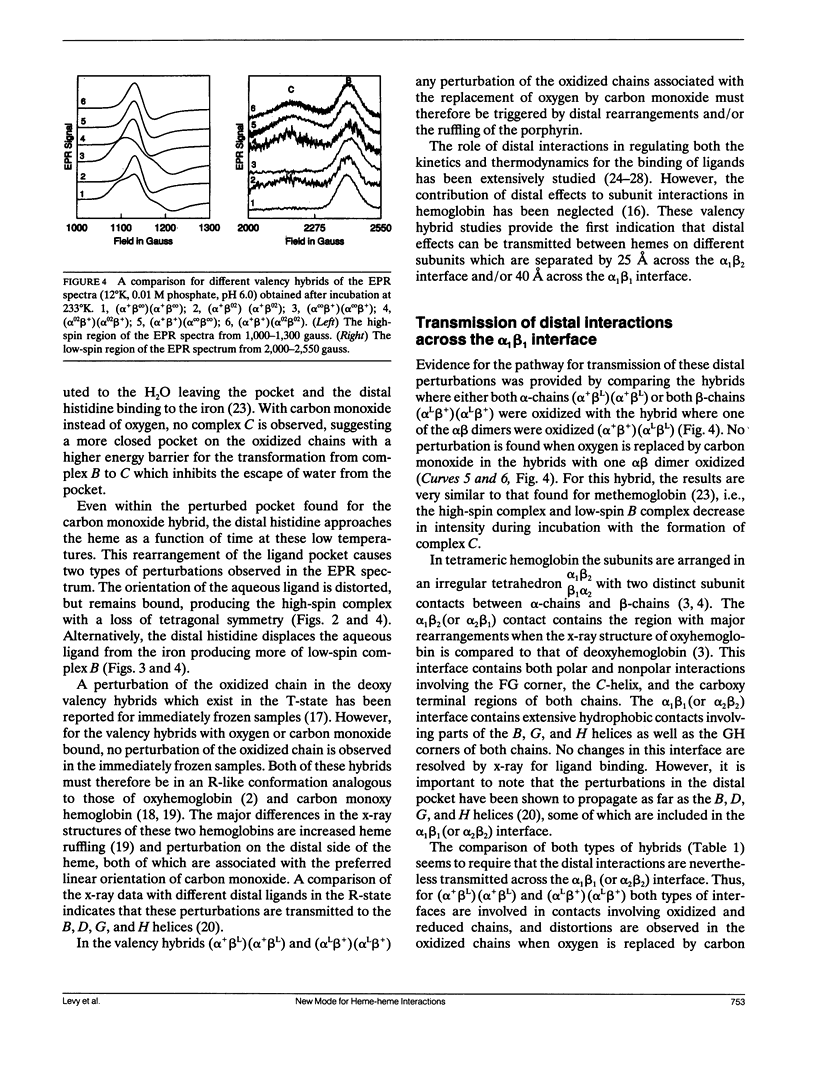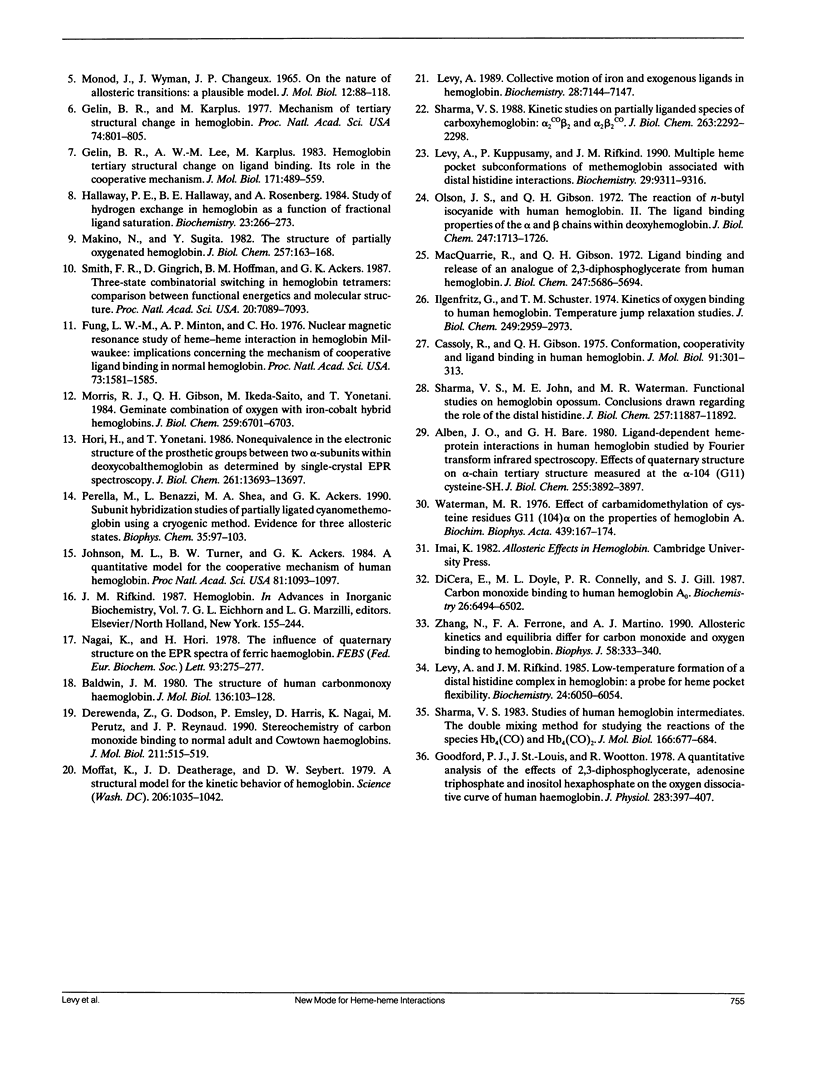Abstract
The distal side of the heme pocket, known to regulate ligand affinity, is shown to be directly involved in subunit interactions. Valency hybrids with oxygen or carbon monoxide bound to the reduced chain are used to model R-state hemoglobin with different distal perturbations. Electron paramagnetic resonance of the oxidized chains shows that the carbon monoxide perturbation is transmitted between subunits to the distal histidine and the oxidized iron center. A comparison of hybrids with only one type of chain oxidized and hybrids with a single alpha beta dimer oxidized is consistent with this perturbation being transmitted across the alpha 1 beta 1 interface. This represents a new mode of subunit interactions in hemoglobin.
Full text
PDF





Images in this article
Selected References
These references are in PubMed. This may not be the complete list of references from this article.
- Alben J. O., Bare G. H. Ligand-dependent heme-protein interactions in human hemoglobin studied by Fourier transform infrared spectroscopy. Effects of quaternary structure on alpha chain tertiary structure measured at the alpha-104(G11) cysteine-SH. J Biol Chem. 1980 May 10;255(9):3892–3897. [PubMed] [Google Scholar]
- Baldwin J. M. The structure of human carbonmonoxy haemoglobin at 2.7 A resolution. J Mol Biol. 1980 Jan 15;136(2):103–128. doi: 10.1016/0022-2836(80)90308-3. [DOI] [PubMed] [Google Scholar]
- Baldwin J., Chothia C. Haemoglobin: the structural changes related to ligand binding and its allosteric mechanism. J Mol Biol. 1979 Apr 5;129(2):175–220. doi: 10.1016/0022-2836(79)90277-8. [DOI] [PubMed] [Google Scholar]
- Cassoly R., Gibson Q. Conformation, co-operativity and ligand binding in human hemoglobin. J Mol Biol. 1975 Jan 25;91(3):301–313. doi: 10.1016/0022-2836(75)90382-4. [DOI] [PubMed] [Google Scholar]
- Derewenda Z., Dodson G., Emsley P., Harris D., Nagai K., Perutz M., Renaud J. P., Reynaud J. P. Stereochemistry of carbon monoxide binding to normal human adult and Cowtown haemoglobins. J Mol Biol. 1990 Feb 5;211(3):515–519. doi: 10.1016/0022-2836(90)90262-k. [DOI] [PubMed] [Google Scholar]
- Di Cera E., Doyle M. L., Connelly P. R., Gill S. J. Carbon monoxide binding to human hemoglobin A0. Biochemistry. 1987 Oct 6;26(20):6494–6502. doi: 10.1021/bi00394a031. [DOI] [PubMed] [Google Scholar]
- Fermi G., Perutz M. F., Shaanan B., Fourme R. The crystal structure of human deoxyhaemoglobin at 1.74 A resolution. J Mol Biol. 1984 May 15;175(2):159–174. doi: 10.1016/0022-2836(84)90472-8. [DOI] [PubMed] [Google Scholar]
- Fung L. W., Minton A. P., Ho C. Nuclear magnetic resonance study of heme-heme interaction in hemoglobin M Milwaukee: implications concerning the mechanism of cooperative ligand binding in normal hemoglobin. Proc Natl Acad Sci U S A. 1976 May;73(5):1581–1585. doi: 10.1073/pnas.73.5.1581. [DOI] [PMC free article] [PubMed] [Google Scholar]
- Gelin B. R., Karplus M. Mechanism of tertiary structural change in hemoglobin. Proc Natl Acad Sci U S A. 1977 Mar;74(3):801–805. doi: 10.1073/pnas.74.3.801. [DOI] [PMC free article] [PubMed] [Google Scholar]
- Gelin B. R., Lee A. W., Karplus M. Hemoglobin tertiary structural change on ligand binding. Its role in the co-operative mechanism. J Mol Biol. 1983 Dec 25;171(4):489–559. doi: 10.1016/0022-2836(83)90042-6. [DOI] [PubMed] [Google Scholar]
- Goodford P. J., St-Louis J., Wootton R. A quantitative analysis of the effects of 2,3-diphosphoglycerate, adenosine triphosphate and inositol hexaphosphate on the oxygen dissociation curve of human haemoglobin. J Physiol. 1978 Oct;283:397–407. doi: 10.1113/jphysiol.1978.sp012508. [DOI] [PMC free article] [PubMed] [Google Scholar]
- Hallaway P. E., Hallaway B. E., Rosenberg A. Study of hydrogen exchange in hemoglobin as a function of fractional ligand saturation. Biochemistry. 1984 Jan 17;23(2):266–273. doi: 10.1021/bi00297a015. [DOI] [PubMed] [Google Scholar]
- Hori H., Yonetani T. Nonequivalence in the electronic structure of the prosthetic groups between two alpha-subunits within deoxycobalthemoglobin as determined by single-crystal EPR spectroscopy. J Biol Chem. 1986 Oct 15;261(29):13693–13697. [PubMed] [Google Scholar]
- Ilgenfritz G., Schuster T. M. Kinetics of oxygen binding to human hemoglobin. Temperature jump relaxation studies. J Biol Chem. 1974 May 10;249(9):2959–2973. [PubMed] [Google Scholar]
- Johnson M. L., Turner B. W., Ackers G. K. A quantitative model for the cooperative mechanism of human hemoglobin. Proc Natl Acad Sci U S A. 1984 Feb;81(4):1093–1097. doi: 10.1073/pnas.81.4.1093. [DOI] [PMC free article] [PubMed] [Google Scholar]
- Levy A. Collective motion of iron and exogenous ligands in hemoglobin. Biochemistry. 1989 Sep 5;28(18):7144–7147. doi: 10.1021/bi00444a002. [DOI] [PubMed] [Google Scholar]
- Levy A., Kuppusamy P., Rifkind J. M. Multiple heme pocket subconformations of methemoglobin associated with distal histidine interactions. Biochemistry. 1990 Oct 9;29(40):9311–9316. doi: 10.1021/bi00492a002. [DOI] [PubMed] [Google Scholar]
- Levy A., Rifkind J. M. Low-temperature formation of a distal histidine complex in hemoglobin: a probe for heme pocket flexibility. Biochemistry. 1985 Oct 22;24(22):6050–6054. doi: 10.1021/bi00343a005. [DOI] [PubMed] [Google Scholar]
- MONOD J., WYMAN J., CHANGEUX J. P. ON THE NATURE OF ALLOSTERIC TRANSITIONS: A PLAUSIBLE MODEL. J Mol Biol. 1965 May;12:88–118. doi: 10.1016/s0022-2836(65)80285-6. [DOI] [PubMed] [Google Scholar]
- MacQuarrie R., Gibson Q. H. Ligand binding and release of an analogue of 2,3-diphosphoglycerate from human hemoglobin. J Biol Chem. 1972 Sep 25;247(18):5686–5694. [PubMed] [Google Scholar]
- Makino N., Sugita Y. The structure of partially oxygenated hemoglobin. A highly reactive intermediate toward a sulfhydryl titrant. J Biol Chem. 1982 Jan 10;257(1):163–168. [PubMed] [Google Scholar]
- Moffat K., Deatherage J. F., Seybert D. W. A structural model for the kinetic behavior of hemoglobin. Science. 1979 Nov 30;206(4422):1035–1042. doi: 10.1126/science.493990. [DOI] [PubMed] [Google Scholar]
- Morris R. J., Gibson Q. H., Ikeda-Saito M., Yonetani T. Geminate combination of oxygen with iron-cobalt hybrid hemoglobins. J Biol Chem. 1984 Jun 10;259(11):6701–6703. [PubMed] [Google Scholar]
- Nagai K., Hori H. The influence of quaternary structure on the EPR spectra of ferric haemoglobin. FEBS Lett. 1978 Sep 15;93(2):275–277. doi: 10.1016/0014-5793(78)81120-x. [DOI] [PubMed] [Google Scholar]
- Olson J. S., Gibson Q. H. The reaction of n-butyl isocyanide with human hemoglobin. II. The ligand-binding properties of the and chains within deoxyhemoglobin. J Biol Chem. 1972 Mar 25;247(6):1713–1726. [PubMed] [Google Scholar]
- Perrella M., Benazzi L., Shea M. A., Ackers G. K. Subunit hybridization studies of partially ligated cyanomethemoglobins using a cryogenic method. Evidence for three allosteric states. Biophys Chem. 1990 Jan;35(1):97–103. doi: 10.1016/0301-4622(90)80064-e. [DOI] [PubMed] [Google Scholar]
- Perutz M. F. Stereochemistry of cooperative effects in haemoglobin. Nature. 1970 Nov 21;228(5273):726–739. doi: 10.1038/228726a0. [DOI] [PubMed] [Google Scholar]
- Shaanan B. Structure of human oxyhaemoglobin at 2.1 A resolution. J Mol Biol. 1983 Nov 25;171(1):31–59. doi: 10.1016/s0022-2836(83)80313-1. [DOI] [PubMed] [Google Scholar]
- Sharma V. S. Kinetic studies on partially liganded species of carboxyhemoglobin: alpha 2 CO beta 2 and alpha 2 beta 2CO. J Biol Chem. 1988 Feb 15;263(5):2292–2298. [PubMed] [Google Scholar]
- Sharma V. S. Studies of human hemoglobin intermediates. The double mixing method for studying the reactions of the species Hb4(CO) and Hb4(CO)2. J Mol Biol. 1983 Jun 5;166(4):677–684. doi: 10.1016/s0022-2836(83)80292-7. [DOI] [PubMed] [Google Scholar]
- Smith F. R., Gingrich D., Hoffman B. M., Ackers G. K. Three-state combinatorial switching in hemoglobin tetramers: comparison between functional energetics and molecular structures. Proc Natl Acad Sci U S A. 1987 Oct;84(20):7089–7093. doi: 10.1073/pnas.84.20.7089. [DOI] [PMC free article] [PubMed] [Google Scholar]
- Waterman M. R. Effect of carbamidomethylation of cysteine residues G11(104)alpha on the properties of hemoglobin A. Biochim Biophys Acta. 1976 Jul 19;439(1):167–174. doi: 10.1016/0005-2795(76)90173-2. [DOI] [PubMed] [Google Scholar]
- Zhang N. Q., Ferrone F. A., Martino A. J. Allosteric kinetics and equilibria differ for carbon monoxide and oxygen binding to hemoglobin. Biophys J. 1990 Aug;58(2):333–340. doi: 10.1016/S0006-3495(90)82380-8. [DOI] [PMC free article] [PubMed] [Google Scholar]




